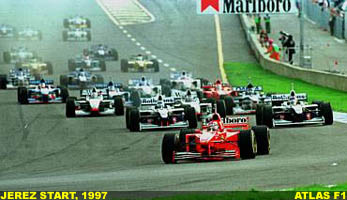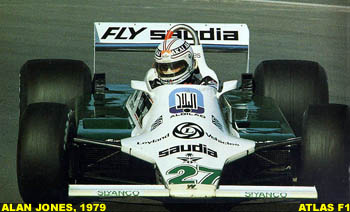 |
|
| The F1 FAQ | |
| by Mark Alan Jones, Australia | |
|
Need help with buying tickets to a Grand Prix? Always wondered where are the best racing schools? Have a question about F1 statistics or history? Well you're not the only one. And it's about time someone came up with the answers to Formula One's most Frequently Asked Questions. Send us your questions, to comments@atlasf1.com - we may not know everything, but we will sure make the effort to find out
The retirement of Alain Prost (and his enforced year off racing), the defection of Nigel Mansell to CART and the death of Ayrton Senna has meant that the last time this quirk of statistics occurred was back in 1991. The champion of 1990 and 1988, Ayrton Senna, was in the McLaren all set to add the his two world title. His great rival Alain Prost (1989 & 1986) was in his second year as lead driver for Ferrari, while the veteran Nelson Piquet (1987) was on a hat trick at Benetton, having won the previous two races in 1990. But that was only three men. If you change the question to insist on 4 world champions, like this year will be, then you have to go back to 1985 (Lauda, Piquet, Rosberg & Jones) but it doesn't really count because Alan Jones and his Lola-Hart (or Hart Attack as Jones used to call it) didn't appear until late in the year. So we then have to go back to 1979 to find a year in which the champions of the previous 5 seasons (and there being 4 of them) started the season. Mario Andretti had the reigning champs #1 on his Lotus. Niki Lauda (1977 & 1975) was looking forward to some exciting aerodynamic breakthroughs at Brabham. James Hunt (1976) was starting what would be his last season with Wolf and Emmerson Fittipaldi (1974) must have been wondering why each time he sat in the Fittipaldi.
Actually, quite a few people asked us about the rule governing the number of teams. And yes, the FIA have set the maximum allowable numbers to 12 two-car teams. No three car teams, or one car teams either. The reasons for this are mainly to prevent what happened in the mid 80's to early 90's when a team would appear, make lots of noise about how good they were going to be, race 2 or 3 seasons, then collapse into debt of 7 figures to be resolved, and leaving Formula One looking a little silly. This happened a lot. The list of F1 teams that died between 1985 and 1995 is long and tragically distinguished. Alfa Romeo, Andrea Moda, AGS, ATS, Brabham, Coloni, Eurobrun, Forti Corse, Larrousse, Life Racing Engines, Lola, Lola-Haas, Lotus, March, Modena-Lambo, Osella, Onyx, Pacific, RAM, Renault, Rial, Scuderia Italia, Simtek, Spirit & Zakspeed. With F1 ever increasing in size and becoming a larger commercial identity, sponsors and investors are demanding security for their not inconsiderable investment. The 12-team rule helps give the present teams a certain security of their place on the grid. It also means that anyone who wants to join the grid will be very cashed up - and that in itself will aid in the new teams security. Put simply, the restriction puts an end to fly-by-night, flash-in-the-pan teams which littered the 80's and 90's. There are presently 11 teams and the 12th spot is being reserved for Honda who will join next year. However, this will make it interesting for Toyota, which announced plans to start a Formula One team in 2003, to be run through the workshops of Toyota Team Europe in Cologne, Germany. To get a spot on the grid they'll have to buy an existing team, or convince Bernie Ecclestone or his successors to relax the 12 team rule.
The FIA use guidelines? I thought they made it up as they went along. Seriously though: the FIA are about to complete the moving of their headquarters from Paris to Geneva. So as soon as their computer network is online in Geneva, the new guidelines should be posted at the website. Failing that, contact the FIA direct and try to obtain a copy through the post. The address is:-
FEDERATION INTERNATIONALE DE L'AUTOMOBILE
Formula One these days is unique in that in every other category in the world there are independents or privateers a few rows back on the grid, running older cars, engines with less horsepower, running less talented drivers, or drivers which own the team. World Rallying, GT Cars, Touring Cars, Superbikes, Formula 3, Formula Ford even 500cc Grand Prix Motorcycles are not an exception. In other categories, most notably Touring Cars, these independents are encouraged, sometimes they even have separate prizes and championship status. Once upon a time Formula One was like that too. The grid in the 60's was littered with Brabhams, Coopers, Lotuses, BRMs and Ferraris running variations of Climax and BRM engines. In the 50's the grid was full of Ferraris, Maseratis & Lago-Talbots that had not seen their factories in years. There was even once a Cooper-Ferrari! Rob Walker was a feature in Formula One from the late 50's to the early 70's. The first appearance of the Rob Walker Racing Team was at the 1953 British Grand Prix where Tony Rolt drove a Lea Francis powered Connaught. The team appeared once a year at the British Grand Prix for a few seasons with a Connaught-Alta then a Cooper-Climax in 1957 for Jack Brabham before visiting a few foreign Grand Prix in 1958. Stirling Moss won the 1958 Argentinean Grand Prix in a Cooper-Climax. In 1960 the team switched to a Lotus-Climax. In 1963 they went back to using Cooper-Climax's. For 1964-5 they had a Brabham-Climax and a Brabham-BRM. 1966 Cooper-Maserati. In 1967 he formed a partnership with Jack Durlacher and in 1968 ran the third Lotus-Cosworth for Jo Siffert. In 1970 Brooke Bond and Rob Walker ran Graham Hill's Lotus-Cosworth. In 1971 Walker joined forces wth John Surtees to form the Surtees team and by 1973 Walker's name was gone from Formula 1's entry lists. His cars won 8 races from 1959 to 1961 with 6 for Stirling Moss and 2 for Maurice Trintignant. A 9th win came for Jo Siffert in 1968. Most statistical lists of Formula One in print and on the web list cars as a Cooper-Climax rather than Rob Walker Racing Team. One book however which supplies the name of the team in addition to 'chassis-engine' is "The Complete Encyclopaedia of Formula One" by Bruce Jones of Autosport fame, a gargantuan tome that in some countries comes with a wheelbarrow to get it home.
Fortunately or unfortunately (depending on who it is) I am not related to any of the following famous Jones' - Alan (1980 F1 WC), Christian (Alan's son), Brad, Bob, Kim & Barry (Australian touring car identities), Dean (cricketer), Alan (international rugby union coach), Barry (politician), Terry (movie director, comic and Monty Python), Michele (triathlete), Michael (All Black Rugby Union), Tom (entertainer), Griff Rhys (British comic), Ernest (psychoanalyst), John Paul (American Naval hero), Inigo (long range weather forecaster), Indiana (fictional archaeologist) or Paula (is 'known' to Bill Clinton). But hey! - My father was a state rowing champion...
|
| Mark Alan Jones | © 1999 Atlas Formula One Journal. |
| Send questions and comments to: comments@atlasf1.com | Terms & Conditions |


